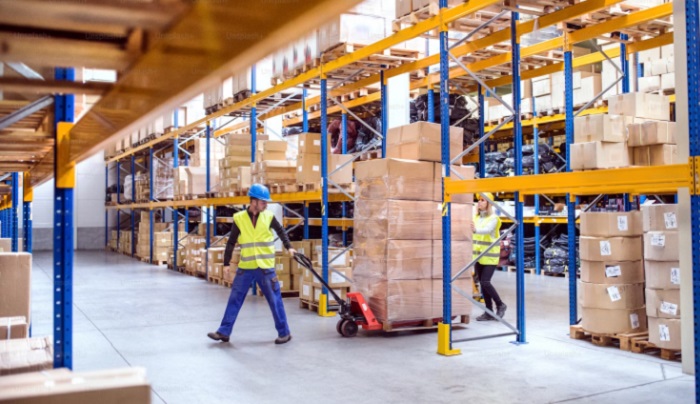In today’s fast-paced business world, how well warehouse processes work is very important to the success of a company.
As consumer needs change quickly and supply lines spread around the world, warehouses have gone from being simple places to store things to being important hubs that directly affect how happy customers are and how well businesses do. Warehouse efficiency means getting the most out of all the different tasks that go into running a warehouse, like keeping track of goods, storing things, moving things around, and processing information.
By making the most of their efficiency, stores can speed up delivery times, make it easier to keep track of goods, and cut down on running costs. This can lead to happier customers and more business growth.
Why optimizing warehouse operations is important
A supply chain that works well needs a warehouse management system that works well. It involves planning how to coordinate different tasks, like getting things, keeping them, picking them out, and sending them out.
Effective warehouse management software cuts costs by reducing waste and making the best use of resources. It is also a key factor in how happy customers are.
- Improvements in technology: There are big changes happening in warehouses because of new technologies like automation, robots, and AI. These improvements make things run more smoothly and cost less to do. For example, it’s becoming more usual to use autonomous drones and joint mobile robots to handle supplies, which makes operations run more smoothly.
- Digital transformation: It’s clear that digital transformation is speeding up in warehouses. This includes the growing use of warehouse management systems (WMS), which analyze data in real time to help keep inventory levels at the right level and work processes running smoothly.
- Online shopping: As online shopping keeps growing, it’s important to get orders filled quickly. To meet customer expectations for fast delivery, warehouses are using technologies and tactics such as micro-fulfillment centers and advanced tracking systems.
- Omnichannel fulfillment: The move toward omnichannel purchasing has led to the growth of WMS systems that can sync inventory and delivery processes across multiple platforms. This is done to meet the growing demand for a smooth shopping experience.
- Supply chain resilience: Because of recent problems in the global supply chain, more attention is being paid to being resilient and flexible. To avoid problems, warehouses are expanding their list of suppliers and looking into different ways to move goods.
- Initiatives for sustainability: Because of worries about the environment, stores are starting to use sustainable methods, like using tools that use less energy and packing materials that are better for the environment.
- The people part: Even though technology has improved, people are still very important. Building workers are being taught new skills to help them deal with new tools and changed jobs in the building.
Using layout and design strategies to improve warehouse operations management
The layout and arrangement of a building are important factors that affect how productive it is as a whole.
Optimizing the plan of warehouse space means placing things in a way that speeds up processes and makes the best use of space. Organizing the shelves and aisles well is an important part of this process. For instance, it is best to put goods that are in high demand close to the packing and mailing areas so that they don’t have to travel too far.
The aisle width should be adjusted to fit the material handling equipment that is being used so that it is easy to move around. Using higher storage boxes to make the most of vertical space can also greatly increase storage capacity, making the best use of the room that is available.
Using technology to make operations run more smoothly
It’s important to keep a competitive edge by incorporating technology into building processes.
ERP and warehouse management systems are the ones that are leading the way in this change in technology.
These technologies make it possible to keep an eye on goods at all times, find the best picking paths, and automate warehouse optimization plans as well as many routine tasks. Things become more accurate and efficient as a result.
Robotics and conveyor systems are two examples of automatic solutions that can make jobs like sorting, picking, and packing even more efficient.
Putting in place the best strategies for managing inventory
Using linked words and sentences can help your material on efficient warehouse operations and inventory management run better and make the story move more smoothly. This is a new version of your content:
Inventory management is one of the most important parts of running a building efficiently. By using just-in-time inventory and other tactics, stores can make the best use of their room, which lowers keeping costs and lowers the chance of products going out of style. Barcoding and RFID tags are important parts of this process because they make tracking goods quickly and accurately. These tools let you see right away how much product you have, which makes stock management better.
When exact demand prediction is paired with smart inventory management, stores can also anticipate what customers will need while cutting down on wasteful spending. At the same time, cycle counting becomes an important way to make sure that inventory is correct. Cycle counting is an ongoing method that involves regularly counting a subset of inventory. This is different from traditional physical inventories, which require that operations stop. This method not only lets you keep checking to make sure the inventory is correct, but it also makes it easy to find and fix mistakes right away, which keeps things running smoothly.
The use of a tiered storage plan also greatly improves the efficiency of inventory. This method involves sorting goods into groups based on how often it is moved and putting frequently used things in places that are easy to get to. This cuts down on the time and effort needed for picking, which greatly improves the speed and accuracy of order processing.
Improvements in inventory management tools have completely changed how stores handle their stock. These modern systems are very good at combining planning tools, which gives important information about what supplies will be needed in the future. They make things easier by handling jobs like organizing, keeping track of goods in different places, and offering the best amount of stock to keep on hand based on past data and predictions for the future.
And it’s impossible to say enough about how important it is for departments to work together to handle supplies well. The buying, sales, and storage teams work together smoothly to make sure that product levels are in line with customer demand and market trends. This multifunctional method is very helpful for avoiding the problems of having too much or too little inventory. It helps keep the inventory balanced so that it can easily adapt to changes in the market.
Changing with the times and meeting customer needs
As the world of logistics moves quickly and changes all the time, it’s important for warehouse operations to be able to adapt to new market trends and customer needs. This flexibility isn’t just about being able to handle more work; it also means being able to quickly change how things are done to meet new needs.
For example, the growth of e-commerce has caused a lot more small package deliveries, which means that the way bulky items are stored and sent needs to change. Agility in the warehouse can be maintained with portable storage systems, adaptable control of the workforce, and technology solutions that can be expanded as needed. By keeping an eye on changes in the market and what customers want, warehouse managers can make changes to their plans and operations before they happen. This keeps the warehouse competitive and efficient.
Using data analytics to make decisions based on insights -The way stores work is changing because of data analytics. By looking at real-time data from a number of different sources, warehouse managers can find inefficient processes, learn more about how customers buy things, and find places where costs can be cut.
Advanced analytics can help figure out the best ways to ship items, predict how much demand there will be, and keep stocking levels and office processes at their best. With this data-driven method, warehouses can make smart choices, guess what trends will happen in the future, and keep improving their plans to make the warehouses run more efficiently.
Sustainability in Warehouse Operations for the Environment
Sustainability is a factor that is growing in importance in warehouse work. Warehouses that are efficient not only help businesses make money, but they also help the environment.
Taking steps like installing solar panels, lighting that uses less energy, and programs to cut down on waste can not only help the environment and slow down warehouse optimization trends, but they can also save money. Sustainable business methods can also help a company’s image and attract customers who care about the environment. Therefore, using green methods is not only the right thing to do as a business, it’s also a smart move.
Bringing together partners in the supply chain to make warehouse operations better
Warehouse activities that work well are connected to the whole supply chain. For smooth operations and on-time delivery, it’s important to work together with wholesalers, makers, carriers, and stores. This can be done with shared data systems, synced processes, and planning that involves everyone. This can help solve common problems like shipping delays and stock control issues.
Warehouses can be more flexible, cut down on wait times, and avoid delays caused by human mistakes or manual processes by working closely with partners in the supply chain. Training and bonus pay for warehouse workers on a regular basis can help them do their jobs better. This joint method makes sure that the whole supply chain works together smoothly, which improves the speed and effectiveness of warehouse operations and, in the end, makes customers happier.
How warehouses will work in the future
Automation and robots are expected to make even more progress in warehouses in the future. These are important technologies for making warehouses better places to work and build. Some new technologies that could change how warehouses work are drones for inventory, self-driving cars for moving things around, and AI-driven predictive maintenance.
Adding Internet of Things (IoT) devices will also make the warehouse more efficient and allow for better real-time tracking and control of warehouse activities, which will help improve processes and better use of resources. These tools will change ABC research and jobs that are done by hand. They will not only make operations more efficient, but they will also create new ways to handle warehouses. This will meet the needs of many businesses and show how important warehouses are in the supply chain.
To Conclude
Increasing the performance of a warehouse is more than just storing and distributing goods.
It includes a lot of different actions and plans that are all meant to make things run more smoothly, cut costs, and make customers happier. Warehouses can reach and keep high levels of efficiency by using new technologies, ensuring the safety and training of workers, adjusting to changes in the market, utilizing data analytics, putting sustainability first, and working together with partners in the supply chain. As the business world changes, so will the tools and tactics used to make warehouses more efficient and productive. This means that the goal is not a set point, but a journey that never ends.


































